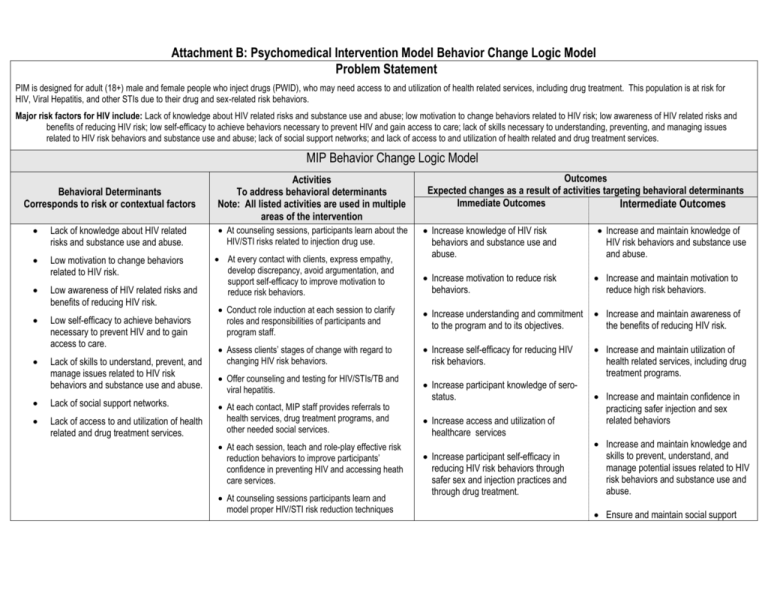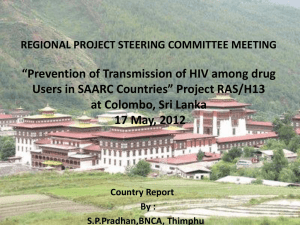Psychomedical Intervention Model Behavior Change
advertisement

Attachment B: Psychomedical Intervention Model Behavior Change Logic Model Problem Statement PIM is designed for adult (18+) male and female people who inject drugs (PWID), who may need access to and utilization of health related services, including drug treatment. This population is at risk for HIV, Viral Hepatitis, and other STIs due to their drug and sex-related risk behaviors. Major risk factors for HIV include: Lack of knowledge about HIV related risks and substance use and abuse; low motivation to change behaviors related to HIV risk; low awareness of HIV related risks and benefits of reducing HIV risk; low self-efficacy to achieve behaviors necessary to prevent HIV and gain access to care; lack of skills necessary to understanding, preventing, and managing issues related to HIV risk behaviors and substance use and abuse; lack of social support networks; and lack of access to and utilization of health related and drug treatment services. MIP Behavior Change Logic Model Behavioral Determinants Corresponds to risk or contextual factors Lack of knowledge about HIV related risks and substance use and abuse. Low motivation to change behaviors related to HIV risk. Low awareness of HIV related risks and benefits of reducing HIV risk. Low self-efficacy to achieve behaviors necessary to prevent HIV and to gain access to care. Lack of skills to understand, prevent, and manage issues related to HIV risk behaviors and substance use and abuse. Lack of social support networks. Lack of access to and utilization of health related and drug treatment services. Activities To address behavioral determinants Note: All listed activities are used in multiple areas of the intervention At counseling sessions, participants learn about the HIV/STI risks related to injection drug use. At every contact with clients, express empathy, develop discrepancy, avoid argumentation, and support self-efficacy to improve motivation to reduce risk behaviors. Outcomes Expected changes as a result of activities targeting behavioral determinants Immediate Outcomes Intermediate Outcomes Increase knowledge of HIV risk behaviors and substance use and abuse. Increase and maintain knowledge of HIV risk behaviors and substance use and abuse. Increase motivation to reduce risk behaviors. Increase and maintain motivation to reduce high risk behaviors. Conduct role induction at each session to clarify roles and responsibilities of participants and program staff. Increase understanding and commitment to the program and to its objectives. Increase and maintain awareness of the benefits of reducing HIV risk. Assess clients’ stages of change with regard to changing HIV risk behaviors. Increase self-efficacy for reducing HIV risk behaviors. Increase and maintain utilization of health related services, including drug treatment programs. Offer counseling and testing for HIV/STIs/TB and viral hepatitis. At each contact, MIP staff provides referrals to health services, drug treatment programs, and other needed social services. At each session, teach and role-play effective risk reduction behaviors to improve participants’ confidence in preventing HIV and accessing heath care services. At counseling sessions participants learn and model proper HIV/STI risk reduction techniques Increase participant knowledge of serostatus. Increase access and utilization of healthcare services Increase participant self-efficacy in reducing HIV risk behaviors through safer sex and injection practices and through drug treatment. Increase and maintain confidence in practicing safer injection and sex related behaviors Increase and maintain knowledge and skills to prevent, understand, and manage potential issues related to HIV risk behaviors and substance use and abuse. Ensure and maintain social support and skills (injection related, sex related, and relapse prevention related). In all sessions, the MIP team works with participants to ensure adequate social support networks. Increase knowledge and skills to prevent, understand, and manage potential issues related to HIV risk behaviors and substance use and abuse. Increase social support networks. networks.





